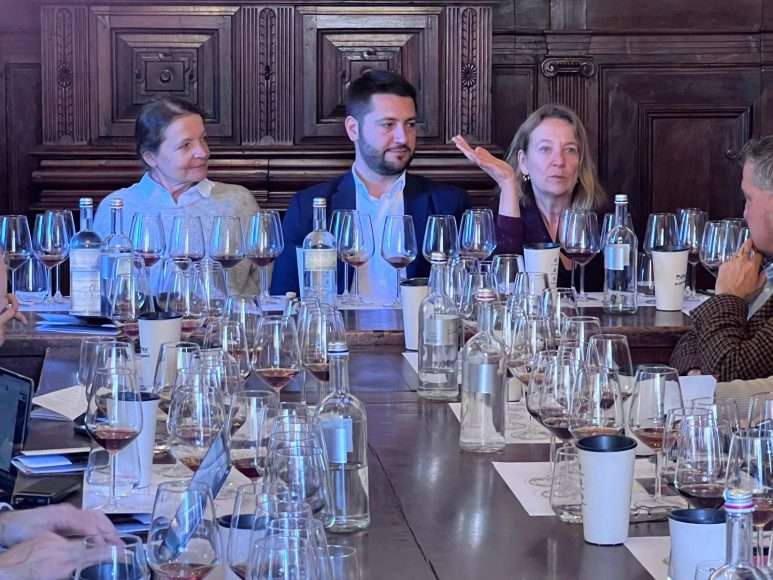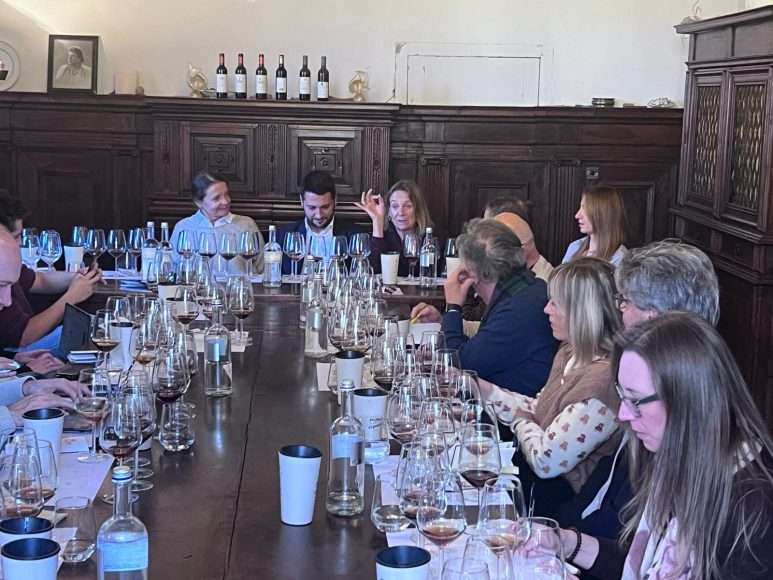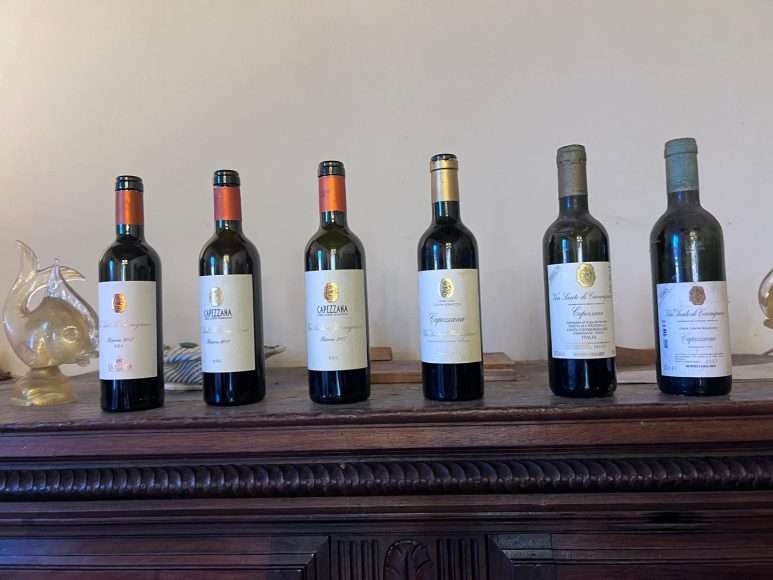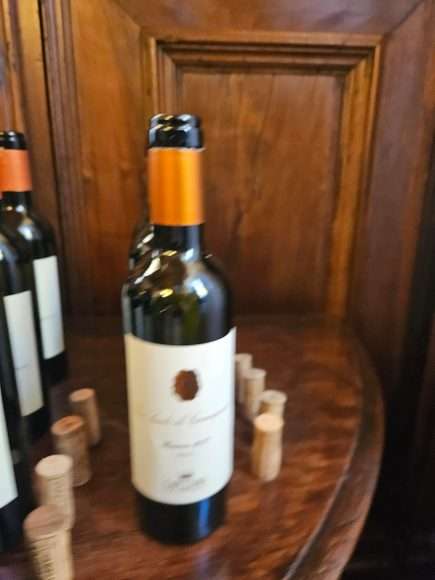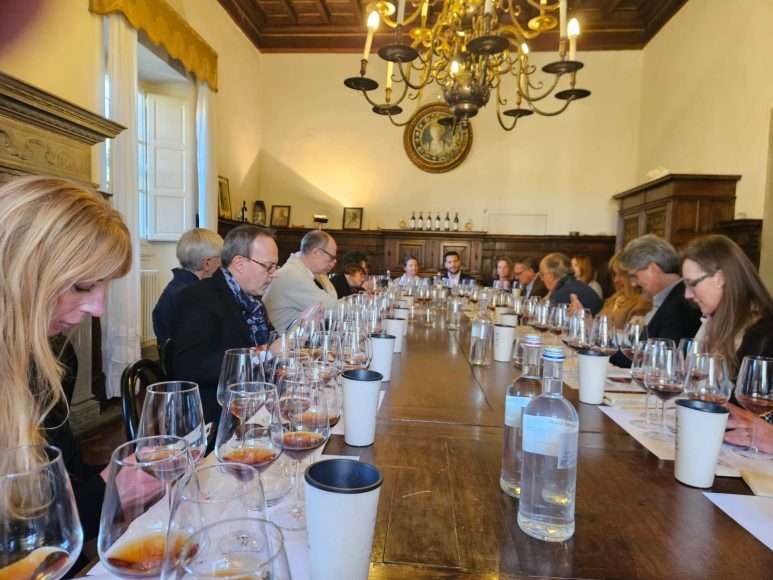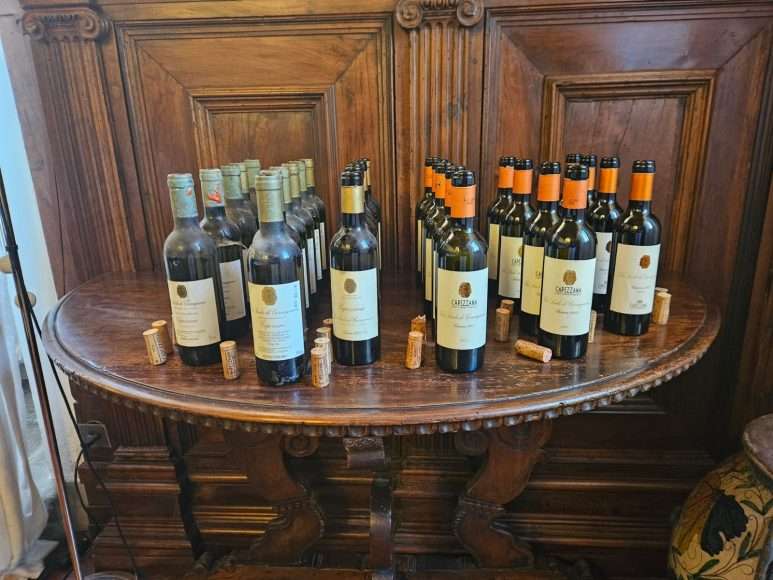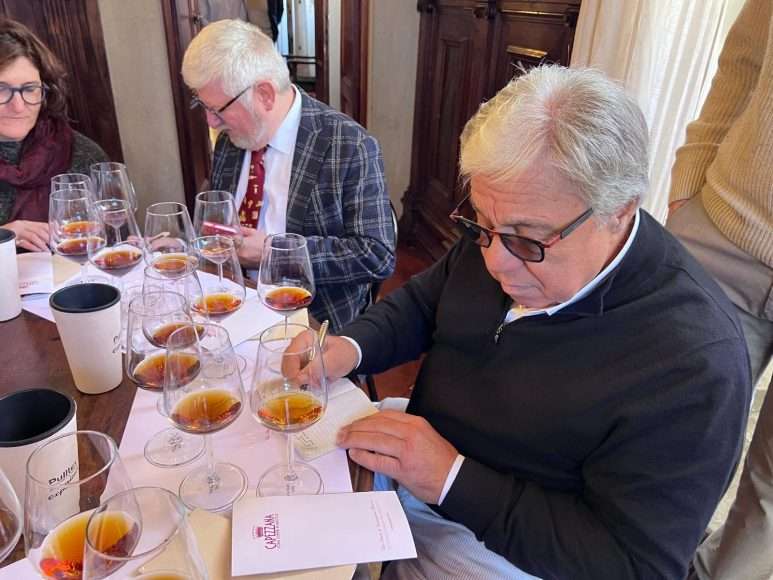Last December the Cantini
Bonacossi family, at their estate of
Capezzana, held a vertical of 6 vintages of its vinsanto.
Every year the company organizes a vertical show of one of their wines.
The mother of this vinsanto, which is produced in Capezzana, is Benedetta Contini Bonacossi who follows the vineyards and the cellar day after day.
This vinsanto is world-famous despite the fact that production is truly modest, generally speaking around 5000 bottles of 0.375l. I had been waiting for a tasting of their vinsanto for a long time. For this wine not all years are the same, in fact, there happens the year in which the sweetness to the taste is very intense and the wine is very dense and sweet and the year in which the body is less dense and the freshness is more noticeable. The flavor notes of chinotto and/or tamarind are very important because they mitigate the sweetness which can sometimes be too evident.
About thirty people were present at the tasting, including journalists, sommeliers and enthusiasts.
During the tasting, as always, I was very focused and I refrained from commenting on the wines, reserving the right to do so at the end. So it was and I spoke analytically about each wine, focusing on the latest vintage, 2017 in which, at the end of my examination, I smelled candied orange peel.
Benedetta confirmed this statement of mine and specified that when she smells the scent of candied orange peel in the wine in the keg, it means that the wine should be bottled. This nectar is produced with Trebbiano and San Colombano grapes.
The tasting was very significant like all verticals because it allows you to get to know the wine in its positive and negative aspects.
After the tasting, a pleasant lunch followed during which the Trebbiano 2023, the Villa di Capezzana Carmignano 2020, the Trefiano 2020, Ugo Contini Bonacossi 2019 were served, the latter with an interminable flavor of violet, the Ghiaie della Furba 2021 with an intense aroma and flavor of violet, in my opinion superior to the pleasant 2019.
It was a pleasantly busy day. These events are unique for their pleasantness. What can we say about the Contini Bonacossi family, they are all pleasant and friendly people.
My tasting notes of the vinsanto vertical follow.
CAPEZZANA
COUNT CONTINI BONACOSSI
VINSANTO DI CAPEZZANA Riserva, 1985 vintage
VINSANTO CARMIGNANO D.O.C.G.
bottles produced n. 4890
After the very rainy first 3 months of the year (408mm), a fairly dry April followed, while rainfall returned in May (92mm) and August (76mm).
A completely dry September and October allowed perfect ripening of the grapes given that the soil had no water shortages.
Light amber color.
From the olfactory stage, aromas of wafers, dried white fig, straw, walnut husk, intense aromas of almond, mint, carob, light aromas of medicinal herbs, peach leaf, dried apricot, Coccoina glue (coconut and almond milk), piscialetto flower (dandelion), ending with memories of coffee grounds.
On the palate it has a medium body and is quite dry, not opulent. Well balanced wine with freshness dominating the alcoholic mass. In the end you can feel a slight burning sensation in the upper gum. Its flavor persistence is long with a finish of chinotto and tamarind.
(95/100)
CAPEZZANA
COUNT CONTINI BONACOSSI
VINSANTO DI CAPEZZANA Riserva, 1996 vintage
VINSANTO CARMIGNANO D.O.C.G.
bottles produced n. 7467
Fresh early spring with a slight delay in budding, recovered during the flowering and fruit setting phase. The summer had a regular trend, interrupted in mid-August with the arrival of the rains, which slowed down ripening. With the warm September, ripening was completed well, the arrival of rain at the end of the month delayed the harvest.
Amber color with orange reflections.
At the beginning the sense of smell is a little closed and then slowly opens up to aromas of Coccoina glue (coconut and almond milk), straw, dried fig, mint, medicinal herbs, rubber, black pepper, nutmeg, intense almond and ending with hints of coffee grounds (it is the coffee powder compacted after use).
Upon tasting it reveals a medium plus body (more than that of the 1985), and has a flavor of chestnut honey, rubber, dried date and dried white fig.
Well balanced wine with the freshness that dominates, without second thoughts, the alcoholic mass. Its taste persistence is long with a finish of chinotto and intense tamarind. This pleasantly bitter note dampens the sweet note of dried dates and dried figs.
(97/100)
CAPEZZANA
COUNT CONTINI BONACOSSI
VINSANTO DI CAPEZZANA Riserva, 2001 vintage
VINSANTO CARMIGNANO D.O.C.G.
bottles produced n. 3980
The seasonal trend confirmed the trend of previous years. A mild winter, with few cold days, was followed by an early spring, with a consequent early vegetative growth, accompanied by a few cold days and sporadic frosts that caused only marginal damage. There was no shortage of rain in the first part of the year. A good reserve of humidity was thus created in the soil which allowed the plants to face the almost completely dry June – August period which characterized a particularly long and hot summer. The grapes arrived perfectly healthy until the end of August.
However, abundant rain in early September completely compensated for the plants’ water shortages. 2001 was an exceptional year for the overall quality of the grapes. The choice of Vinsanto began on September 20th and continued until the first week of October, while the pressing of the bunches was carried out on February 6th 2022.
Dark amber, brick coat, with orange edge.
The olfactory treasure chest is rich in aromas among which emerge medicinal herbs, split almond, dried white fig, dried chestnut, mint, medicine drawer, hints of black pepper, nutmeg, boiled chestnut with dried wild fennel, hard barley candy, straw, hints of paint enamel to finish with brushstrokes of honey.
At the right level you can perceive a very strong medium body, with a flavor of dried white fig and dried date.
The freshness is not lacking, it is true that it completely envelops the alcoholic mass. Its taste persistence is very long with a finish always of dry white fig and dried date.
Quite opulent but balanced wine.
I remember the 2000 was drier with less structure and more freshness.
(96/100)
CAPEZZANA
COUNT CONTINI BONACOSSI
VINSANTO DI CAPEZZANA Riserva, 2007 vintage
VINSANTO CARMIGNANO D.O.C.G.
bottles produced n. 5640
A mild winter with above average temperatures and below normal rainfall, with an average dry and warm spring which allowed rapid and uniform vegetative development. The summer climate was very favourable, with great heat between June and July, with light rains after the second half of August which helped the grains to swell. A dry September which allowed for optimal ripening of the grapes. The selection of the Vinsanto grapes began on September 23rd while the pressing took place on February 1st 2008.
Amber color – mahogany (it is lighter than 2001). Multifaceted sense of smell with intense aromas of medicinal herbs, almond and dried date.
The olfactory journey continues with notes of cooked sugar, dried white fig, hints of acetic acid and tow soaked in wine.
When tasted it shows intense sweetness of dried white fig, dried date and wildflower honey. The body is medium, very structured. Balanced wine with freshness that dominates the alcoholic mass. Its taste persistence is long,
A very sweet wine that would have needed more freshness to loosen the density and a final note of chestnut honey that would loosen its sweetness a little.
(It’s thicker and sweeter than the 2001)
(94/100)
CAPEZZANA
COUNT CONTINI BONACOSSI
VINSANTO DI CAPEZZANA Riserva, 2013 vintage
VINSANTO CARMIGNANO D.O.C.G.
bottles produced n. 5256
During the winter and early spring, we had an abundance of rain, but as May arrived the weather changed to a warm, dry spring. The vegetative development phase was very good, but veraison arrived rather late and led to a later than average start to the harvest. The selection of Trebbiano and San Colombano grapes for Vin Santo began on 23 September, in line with previous years. The drying lasted until February 10, 2014.
Fairly light amber color.
Scents of almond, medicinal herbs, almond shell, thousand flower honey, dried fig to finish with puffs of old wood.
Mouth with flavor of cherry in spirit, thousand flower honey and almond.
The body is medium, dense but less than that of 2007. The freshness makes the wine balanced, without perceiving the alcoholic mass. Its taste persistence is long with a chinotto finish and light tamarind and a very almond finish.
(96/100)
CAPEZZANA
COUNT CONTINI BONACOSSI
VINSANTO DI CAPEZZANA Riserva, 2017 vintage
VINSANTO CARMIGNANO D.O.C.G.
bottles produced n. 5008
A vintage whose key element is extreme meteorological variability. Mild winter with irregular rainfall which allowed an early vegetative start. Late frosts in the lower vineyards between April 20th and 21st. A hot and very dry spring, a climate that continued throughout the summer, one of the driest and hottest ever. The yields were very low but overall a year characterized by full and rich wines, with incredible power, structure and length. The selection of the bunches for Vin Santo began early on 12 September and also due to the large concentration on the vine, the drying ended on 22 December.
The glass shows amber color with mahogany reflections.
On the nose it expresses intense aromas of wafers followed by chinotto, tamarind, iodine, mint, almond shell, tow, hydrolytin (powder to make natural water carbonated) to finish with whispers of candied orange peel.
When tasted, it has a medium body and is denser than the 2011 and 2007. The freshness is overwhelming, overflowing and makes the alcoholic mass completely harmless.
Initial almond flavour. Its flavor persistence is long with a finish of chinotto and light tamarind.
Nice wine, pleasant with a very long future thanks to its rich freshness.
(98/100)

